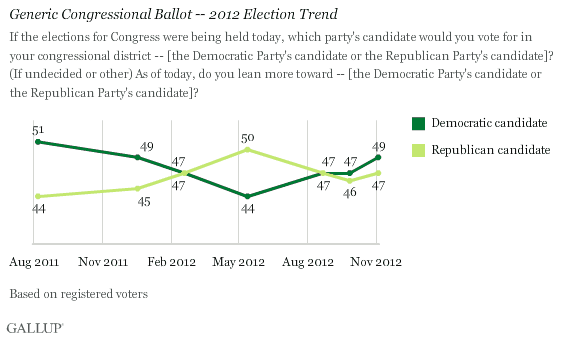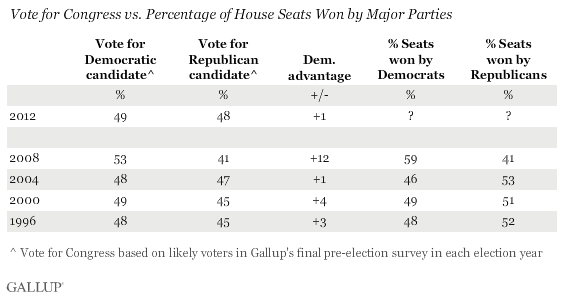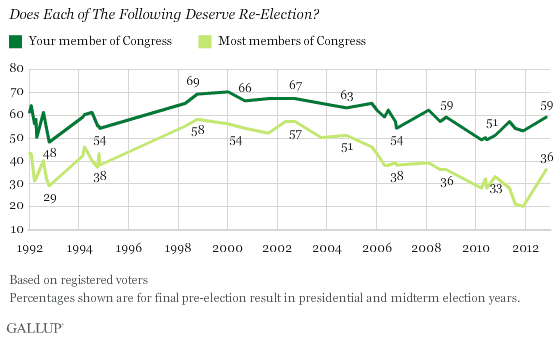PRINCETON, NJ -- Gallup's final pre-election estimate of the vote for the U.S. House of Representatives, based on Nov. 1-4 Gallup Daily tracking, finds voters evenly divided in their support for Republican and Democratic candidates. Forty-nine percent of likely voters are backing Democratic candidates for Congress and 48% are backing Republican candidates.

Democrats hold a slight lead in party preferences for Congress among all national adults as well as with registered voters. However, just as Gallup sees with the vote for president, the Democrats lose their advantage when it comes to the smaller pool of likely voters expected to vote on Tuesday.
Among registered voters, the Democrats had a sizable lead in August 2011, but party preferences have been narrower for most of 2012, except for one poll in May in which Republicans had a significant lead.

History Suggests Party Control of Congress Won't Change
The generic ballot is a summary measure of the percentage of all votes Americans will cast for Republican and Democratic candidates across the nation's 435 congressional districts. It is generally a good predictor of the national two-party vote in U.S. House of Representatives elections in midterm years, but is somewhat less reliable in presidential election years.
Still, it is useful to note that in three of the four most recent presidential election years -- 1996, 2000, and 2004 -- Republicans maintained their majority status in the House of Representatives. All of these were years when the Democrats held advantages on the generic ballot among likely voters of between one and four percentage points. By contrast, the Republicans failed to win a majority of seats in the House in 2008, when the Democrats held a 12-point advantage on the generic ballot.
Thus, the Democrats' current one-point advantage in voters' generic ballot preferences for Congress suggests Republicans will maintain a majority of seats in the U.S. House coming out of Tuesday's elections.

Voters Still Say Their Own Member of Congress Deserves Re-Election
A separate measure of how incumbents might fare on Tuesday comes from Gallup's question asking Americans whether their own member of Congress deserves re-election. The 59% of registered voters saying theirs does is higher than the 51% saying this in 2010 and the 54% in 2006 -- both years when there was a high degree of seat turnover, in addition to a change in party control of Congress.
More generally, Americans have been less positive about their member of Congress' worthiness to be re-elected in recent years than they were from 1998 through 2004, although more satisfied than in 1992 (when Democrats held on to their majority in Congress).
Americans are always less positive about whether most members of Congress deserve re-election than whether their own does, and that continues today. Barely a third of registered voters, 36%, say most members deserve re-election, consistent with the 2006 and 2008 elections, but slightly higher than in 2010.

Few Ticket Splitters
The electorate is closely divided in its voting preferences for Congress, just as it is in its vote for president. This reflects a high degree of similarity in Americans' party preferences for both offices. Ninety-one percent of President Barack Obama's voters are backing the Democratic candidate in their district, while 90% of Mitt Romney's voters are backing the Republican. Conversely, just 7% of Obama's voters are supporting the Republican candidate for Congress and 9% of Romney's voters are supporting the Democrat.
Implications
While Democrats edge out Republicans, 49% to 48%, in likely voters' party preferences for Congress, Gallup's historical trends suggests this is not a large enough difference to give the Democrats a House majority, particularly given the Republicans' current 50-seat advantage.
Still, there are some indications that the battle for party control of Congress could be close. First, while the majority of Americans say their own member of Congress deserves re-election, the 59% doing so is lower than Gallup found from 1998 through 2004, and is not much higher than the 54% in 2006, when the Republicans were voted out of power. Additionally, the 36% saying most members of Congress deserve re-election is comparable to percentages found for several elections when party control changed hands, including 1994, 2006, and 2010. Finally, with most Americans indicating they will vote for the same party for Congress as they do for president, the fate of many incumbents, if not party control, may depend on how the man at the top of their party's ticket performs.
Survey Methods
Results are based on telephone interviews conducted Nov. 1-4, 2012, on the Gallup Daily Election Tracking Poll, with a random sample of 3,117 adults, aged 18 and older, living in all 50 U.S. states and the District of Columbia.
For results based on the total sample of national adults, one can say with 95% confidence that the maximum margin of error is ±2 percentage points.
For results based on the total sample of 2,854 registered voters, one can say with 95% confidence that the maximum margin of error is ±2 percentage points.
Results for likely voters are based on the subsample of 2,551 survey respondents deemed most likely to vote in the November 2012 general election, according to a series of questions measuring current voting intentions and past voting behavior. For results based on the total sample of likely voters, one can say with 95% confidence that the margin of sampling error is ±2 percentage points.
Interviews are conducted with respondents on landline telephones and cellular phones, with interviews conducted in Spanish for respondents who are primarily Spanish-speaking. Each sample includes a minimum quota of 250 cell phone respondents and 250 landline respondents per 500 national adults, with additional minimum quotas among landline respondents by region. Landline telephone numbers are chosen at random among listed telephone numbers. Cell phone numbers are selected using random-digit-dial methods. Landline respondents are chosen at random within each household on the basis of which member had the most recent birthday.
Samples are weighted by gender, age, race, Hispanic ethnicity, education, region, adults in the household, population density, and phone status (cell phone only/landline only/both, cell phone mostly, and having an unlisted landline number). Demographic weighting targets are based on the March 2011 Current Population Survey figures for the aged 18 and older non-institutionalized U.S. population. All reported margins of sampling error include the computed design effects for weighting.
In addition to sampling error, question wording and practical difficulties in conducting surveys can introduce error or bias into the findings of public opinion polls.
View methodology, full question results, and trend data.
For more details on Gallup's polling methodology, visit www.gallup.com.
